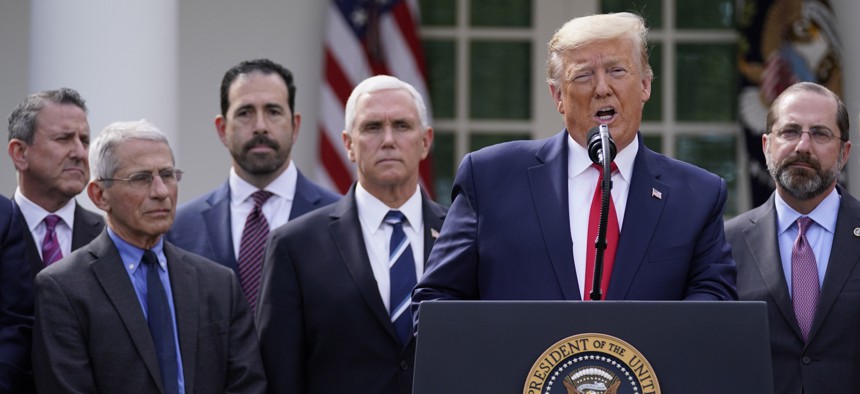
President Donald Trump speaks during a news conference about the coronavirus in the Rose Garden of the White House, Friday, March 13, 2020, in Washington. AP Photo/Evan Vucci
Trump Declares National Emergency Over Coronavirus
After weeks of downplaying the virus’s likely impact in the United States, the president announced new measures for containing its spread, promising 1.4. million tests next week.
The article has been updated.
President Donald Trump invoked a national emergency over coronavirus on Friday, a move that he said will unlock tens of billions of dollars in federal aid to state and local governments, provide access to millions of tests and allow him to loosen legal strictures on hospitals to help them respond to the pandemic.
“To unleash the full power of the federal government, I am officially declaring a national emergency,” Trump said in the Rose Garden. “Two very big words. The action I am taking will open up access to…a very important and large amount of money for states and territories and localities.”
Trump is also “urging every state to set up emergency operations centers effective immediately,” he said.
Appearing alongside multiple health-care and business executives, Trump vowed an additional 1.4 million tests for the virus will be available by next week, with a goal of 5 million within one month. Officials said that Americans would be able to go to drive-thru testing sites in the parking lots of several major retailers, including Walmart, Target, CVS, and Walgreens, but gave no date for when that service would be available.
So far, the effort to test Americans for COVID-19 has been “failing,” Anthony Fauci, head of infectious diseases at the National Institutes of Health, told Congress on Wednesday. The CDC stopped reporting test numbers nearly two weeks ago, but fewer than 15,000 Americans are known to have been tested so far — fewer per capita than in China, South Korea, the UK, and other countries.
Asked whether he took responsibility for the testing shortfall, Trump responded, “I don’t take responsibility at all.”
Trump invoked the 1976 National Emergencies Act, which gives the president a broad swath of powers — including things like seizing control of the internet, if he chooses. Last year, Trump invoked the law to divert funding already appropriated for other programs to pay for his signature border wall.
Democrats have been pushing Trump to invoke the Stafford Act, which gives the president much narrower powers, and as late as Thursday, Trump appeared to be hesitating.
Related: The Four Key Reasons the US Is So Behind on Coronavirus Testing
Related: The Prognosis: Latest News on Coronavirus & National Security
“It may be some of the more minor things at this point,” he said in the Oval Office. “But, you know, look, we're in great shape. Compared to other places, we are in really good shape, and we want to keep it that way. That's why I did the ban with respect to Europe.”
Still, Democrats swiftly praised the declaration.
“This declaration is the right call as it will allow the federal government to immediately implement emergency measures to respond to this crisis and free up significant federal funding to help New Hampshire and other states,” said Sen. Jeanne Shaheen, D-N.H., in a statement.
From the beginning of the crisis, Trump has downplayed its scope and impact, at one point calling criticism of his response a “hoax” comparable to the Russia investigation, and two weeks ago, declaring incorrectly that the number of U.S. cases “within a couple of days is going to be down to close to zero.”
Trump has continued to predict a swift end to the crisis, and struck a sanguine tone about its economic impact in his Oval Office address Wednesday night. “This is not a financial crisis,” he said. “This is just a temporary moment in time that we will overcome as a nation and a world.”
“This will pass,” Trump said Friday in the Rose Garden. “We’re going to be stronger for it.”
The declaration joins a hodgepodge of other emergency authorities invoked by other federal agencies and state governments.
The Department of Health and Human Services declared coronavirus a public health emergency in January, a designation that allowed the administration to limit travel to the United States from China. Several state governments have also declared emergencies, including New York, allowing Gov. Andrew Cuomo to declare the town of New Rochelle a “containment zone.”
Trump also announced a series of executive actions on Friday aimed at mitigating the economic fallout from the disease, including waiving interest on student loans.
Trump’s announcement comes as House Democrats were pushing for a late-Friday vote on legislation to provide financial help to coronavirus victims. House Speaker Nancy Pelosi, D-Caif., has been grappling with GOP lawmakers and the White House over the stimulus package for days.
Confirmed coronavirus cases in the United States exceeded 1,875 on Friday afternoon, according to the New York Times’ count. One week ago, there were 252. Two weeks ago, there were 24.
NEXT STORY: Iran Threat Remains ‘Very High,’ US General Says




